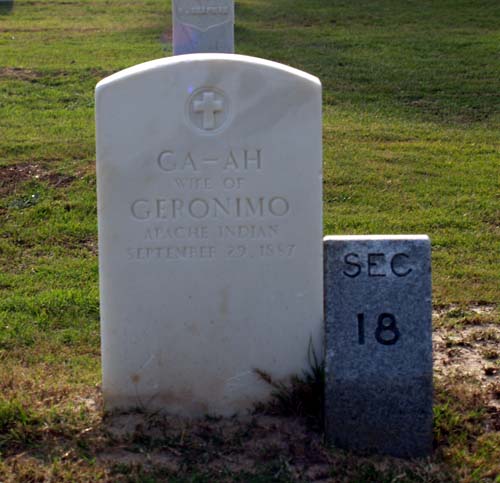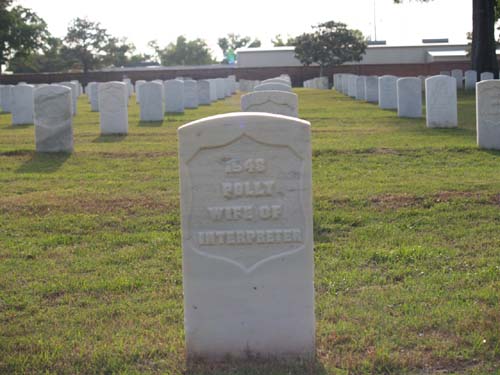Post by Historian on May 21, 2009 11:08:23 GMT -5
"Geronimo"
by Barbara Ping
Geronimo was a Bedonkohe [Chiricahua] Apache who lived in the "Southern Four Corners" region (southeastern Arizona, southwestern New Mexico, northwestern Chihuahua, northeastern Sonora) during the late 1800's. Born in the 1820's, scholars disagree on whether his birthplace was actually in Arizona or New Mexico. His original name "Goyakla," or "one who yawns," was replaced with "Geronimo" by Mexican soldiers.
By the 1850's Geronimo was married with three children and also supporting his widowed mother. The entire Bedonkohe group went to Mexico in the summer of 1858 to trade with the Mexicans living in a town Apache's called Kas-ki-yeh (probably Janos). After their camp was established, the women and children remained behind while a group of men went into town to trade. On the third day, the men returned to the camp to discover that a band of Mexican soldiers from another town had come and massacred many people, mostly women and children. Among the dead were Geronimo's mother, wife, and children. From that day, he vowed vengeance upon the Mexican troopers. He became a War Chief, leading the Chiricahua Apache in raids on Mexican towns and villages as well as attacking people throughout southern Arizona and New Mexico.
Some people give Geronimo the distinction of being the last Indian to surrender to the United States but actually he surrendered several times. In 1884, Geronimo, the Bedonkohe tribe, and members of other Apache groups surrendered and were taken to the San Carlos Indian Reservation. In 1885, he and 144 others escaped from the reservation, but surrendered to U.S. authorities ten months later in Mexico. As they were brought back across the United States-Mexico border, however, Geronimo and a small band escaped fearing they would be murdered. This band remained at large for the next five months despite being hunted by 5,500 men in a sweeping search that ranged over 1645 miles.
The negotiations for Geronimo's final surrender took place in Skeleton Canyon, near present day Douglas, Arizona, in September, 1886. He and approximately 40 others, as well as Western Apache scouts who had faithfully served the U.S. military in tracking Geronimo's band, were taken into custody. General Nelson A. Miles promised that they would be able to return to Arizona after a short incarceration in Florida.
The group was sent by train to Florida where they were detained for a year at Fort Pickens and their families at Fort Marion. The warriors were reunited with their families the following year at Mount Vernon, Alabama. The entire group was moved to Fort Sill, Oklahoma in 1894, still classified as "prisoners of war". Geronimo lived at Fort Sill until his death, in 1909, at the age of 85. During his later life Geronimo was a celebrity. He made appearances at the 1898 Trans-Mississippi and International Exposition, the 1901 Pan American Exposition, and the 1904 Louisiana Purchase Exposition and was often presented as the "Apache terror." He was also given the honor of riding in Theodore Roosevelt's inaugural parade after which he was given a personal audience with the President. Although he pled "Let me die in my own country, an old man who has been punished enough and is free," he was never allowed to return to Arizona.
*******
"Geronimo - The Last Apache Holdout"
by Kathy Weiser
Geronimo was born of the Bedonkohe Apache tribe in No-doyohn Canon, Arizona, June, 1829, near present day Clifton, Arizona. The fourth in a family of four boys and four girls, he was called Goyathlay (One Who Yawns.) In 1846, when he was seventeen, he was admitted to the Council of the Warriors, which allowed him to marry. Soon, he received permission; married a woman named Alope, and the couple had three children.
In the mid 1850s, the tribe, who was at peace with the Mexican towns and neighboring Indian tribes, traveled into Old Mexico where they could trade. Camping outside a Mexican town they called Kas-ki-yeh, they stayed for several days. Leaving a few warriors to guard the camp, the rest of the men went into town to trade. When they were returning from town, they were met by several women and children who told them that Mexican troops had attacked their camp.
They returned to camp to find their guard warriors killed, and their horses, supplies and arms, gone. Even worse, many of the women and children had been killed as well. Of those that lay dead were Goyathlay’s wife, mother, and three children and as a result, he hated all Mexicans for the rest of his life.
It was the slaughter of his family that turned him from a peaceful Indian into a bold warrior. Soon, he joined a fierce band of Apaches known as Chiricahuas and with them, took part in numerous raids in northern Mexico and across the border into U.S. territory which are now known as the states of New Mexico and Arizona. It was those Mexican adversaries that gave him the nickname of "Geronimo", the Spanish version of the name "Jerome".
In ever increasing numbers, Geronimo fought against both Mexicans and white settlers as they began to colonize much of the Apache homelands. However, by the early 1870s, Lieutenant Colonel George F. Crook, commander of the Department of Arizona, had succeeded in establishing relative peace in the territory. The management of his successors, however, was disastrous.
In 1876 the U.S. government attempted to move the Chiricahua from their traditional home to the San Carlos Reservation, a barren wasteland in east-central Arizona, described as "Hell's Forty Acres." Deprived of traditional tribal rights, short on rations and homesick, they revolted.
Spurred by Geronimo, hundreds of Apaches left the reservation and fled to Mexico, soon resuming their war against the whites. Geronimo and his followers began ten years of intermittent raids against white settlements, alternating with periods of peaceful farming on the San Carlos reservation.
In 1882, General George Crook was recalled to Arizona to conduct a campaign against the Apaches. Geronimo surrendered in January 1884, but, spurred by rumors of impending trials and hangings, took flight from the San Carlos Reservation on May 17, 1885, accompanied by 35 warriors, and 109 other men, women and children.
During this final campaign, at least 5,000 white soldiers and 500 Indian auxiliaries were employed at various times in the capture of Geronimo's small band. Five months and 1,645 miles later, Geronimo was tracked to his camp in Mexico's Sonora Mountains.
Exhausted, and hopelessly out numbered, Geronimo surrendered on March 27, 1886 at Cañon de Los Embudos in Sonora, Mexico. His band consisted of a handful of warriors, women, and children. Also found was a young white boy named Jimmy "Santiago" McKinn, that the Indians had kidnapped some six months earlier in September. The "rescued" boy had become so assimilated to the Apache lifestyle, he cried when he was forced to return to his parents.
Also traveling with General Crook was the photographer, C.S. Fly of Tombstone fame. After the bands capture, he was able to take some of the most famous photographs in U.S. history.
The soldiers gathered the group and began the trek to Fort Bowie, Arizona. However, near the border, Geronimo, fearing that they would be murdered once they crossed into U.S. territory, bolted with Chief Naiche, 11 warriors, and a few women and boys, who were able to escape back into the Sierra Madra. As a result, Brigadier General Nelson A. Miles replaced Crook as commander on April 2, 1886.
At a conference on September 3, 1886, at Skeleton Canyon in Arizona, General Miles induced Geronimo to surrender once again, promising him that, after an indefinite exile in Florida, he and his followers would be permitted to return to Arizona.
The promise was never kept. Geronimo and his fellow prisoners were shipped by box-car to Florida for imprisonment and put to hard labor.
It was May 1887 before he saw his family. Several years later, in 1894, he was moved to Fort Sill in Oklahoma Territory where he attempted to “fit in.” He farmed and joined the Dutch Reformed Church, which expelled him because of his inability to resist gambling.
As years passed, stories of Geronimo's warrior ferocity made him into a legend that fascinated non-Indians and Indians alike. As a result, he appeared at numerous fairs, selling souvenirs and photographs of himself. In 1905 he was quite the sensation when he appeared in President Theodore Roosevelt's inaugural parade. Geronimo dictated his memoirs, published in 1906 as Geronimo's Story of His Life.
Never having seen his homeland of Arizona again, Geronimo died of pneumonia on February 17, 1909 and was buried in the Apache cemetery at Fort Sill, Oklahoma.
*******
Geronimo with General George Crook in council - 27 March 1886

Geronimo - Chiricahua Apache - 1886
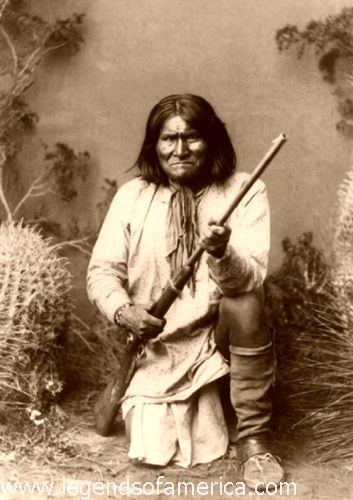
Geronimo - Chiricahua Apache - 1886

Geronimo - Chiricahua Apache - 1886

{The photograph below, taken on 10 September 1886 shows Apache prisoners at rest stop near Nueces River, Texas along the route to Fort Sam Huston in San Antonio.}
Naiche (seated in front - third from left), Geronimo (seated in front - third from right) - Chiricahua Apache - 1886
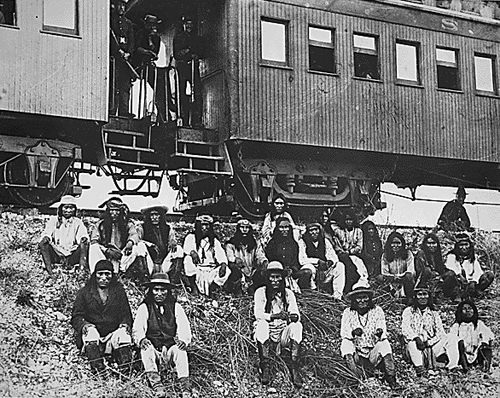
Geronimo - Chiricahua Apache - 1886

Geronimo - Chiricahua Apache - 1886
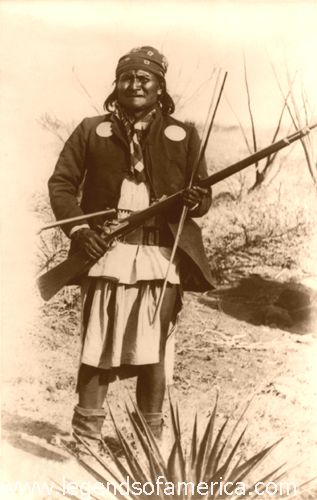
Geronimo (far right) at Ft. Sam Huston, San Antonio, TX - Chiricahua Apache - 1886

Geronimo (standing in center) at Ft. Sam Huston, San Antonio, TX - Chiricahua Apache - 1886

Geronimo at Ft. Sam Huston, San Antonio, TX - Chiricahua Apache - 1886

Geronimo at Mt. Vernon Barracks, Alabama - Chiricahua Apache - 1887

Geronimo (far right) at Mt. Vernon Barracks, Alabama - Chiricahua Apache - 1887

Geronimo - Chiricahua Apache - 1897

Geronimo (center) - Chiricahua Apache - 1901

Geronimo - Chiricahua Apache - 1903
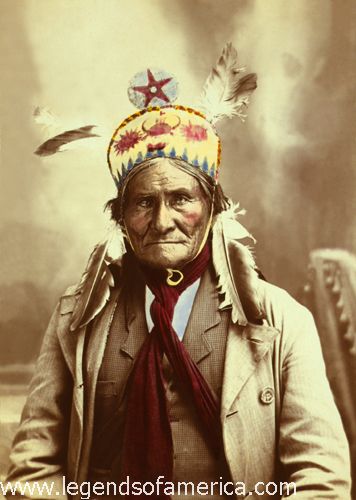
Geronimo - Chiricahua Apache - 1904

Geronimo - Chiricahua Apache - 1905

{The photo below shows Geronimo driving a car. It was taken on 11 June 1905, at the Miller brothers' 101 Ranch, located southwest of Ponca City, Oklahoma. The "photo op" was taken during a special 101 Ranch show for the press, and hundreds of newspaper editors and reporters flocked to it. At the time, Geronimo was still imprisoned at Fort Sill, Oklahoma, and guards accompanied him to the show. The man in a feathered headdress to Geronimo's left is Edward LeClair Sr. (Ponca). Geronimo so admired LeClair's beaded vest that he was presented to him later in the day. When Geronimo died in 1909, he was buried in the vest.}
Geronimo - Chiricahua Apache - 1905

Geronimo - Chiricahua Apache - 1907
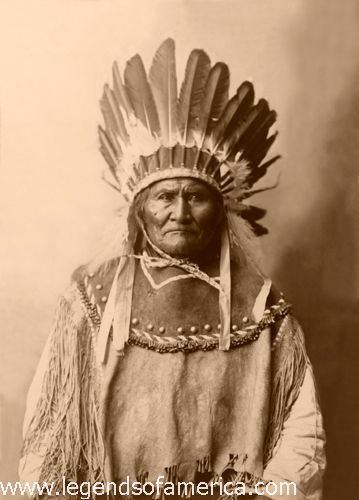
Geronimo - Chiricahua Apache - no date
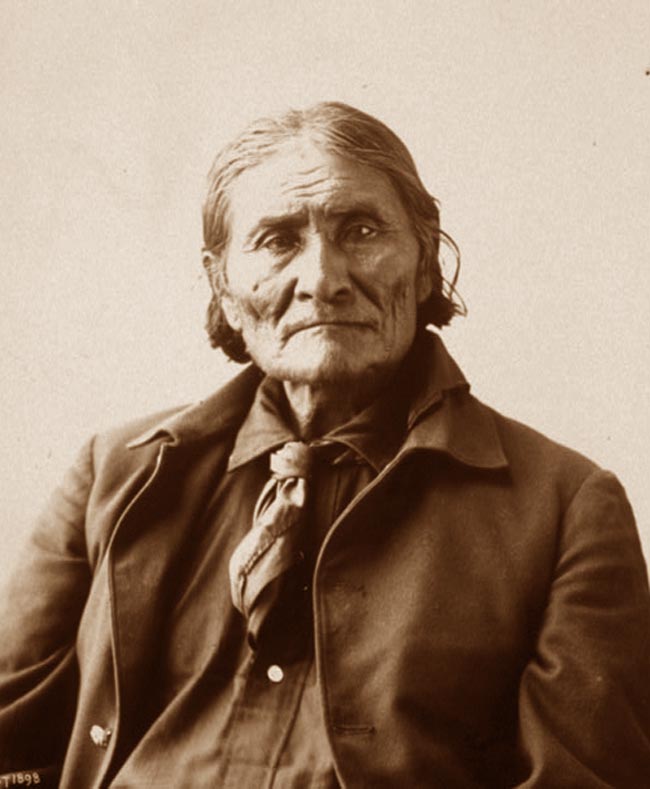
Geronimo - Chiricahua Apache - no date

Geronimo and family at Fort Sill, OK - Chiricahua Apache - no date

Geronimo - Chiricahua Apache - no date
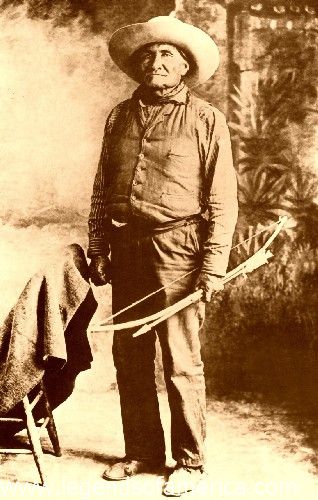
Geronimo - Chiricahua Apache - no date
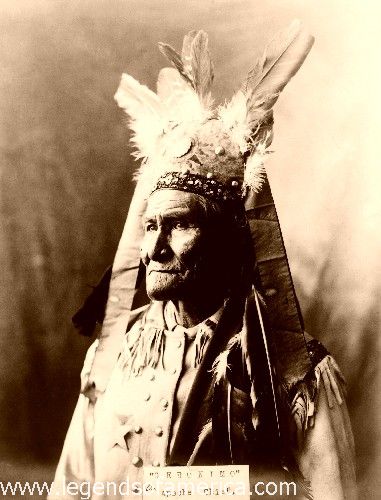
Geronimo (Chiricahua Apache), Christian Waiche - no date

Geronimo - Chiricahua Apache - no date

Geronimo - Chiricahua Apache - no date
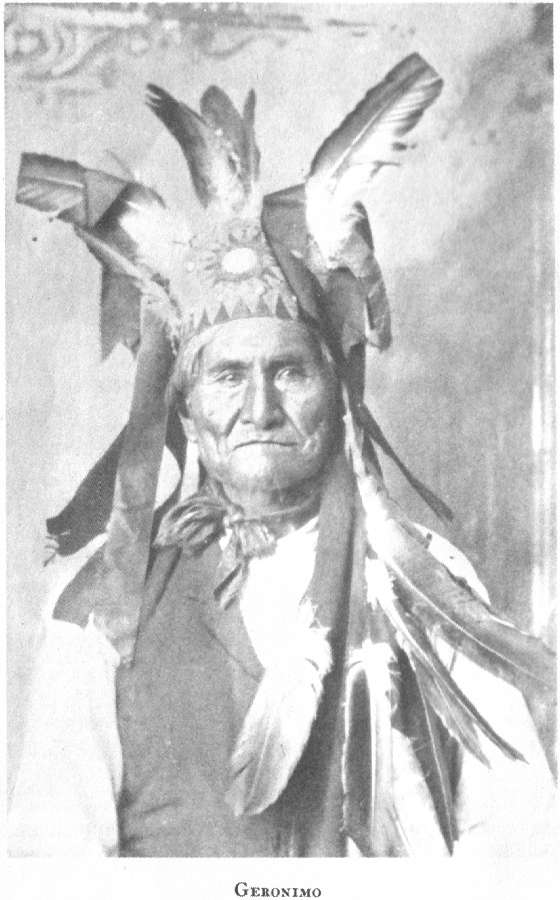
Geronimo (center) - Chiricahua Apache - no date
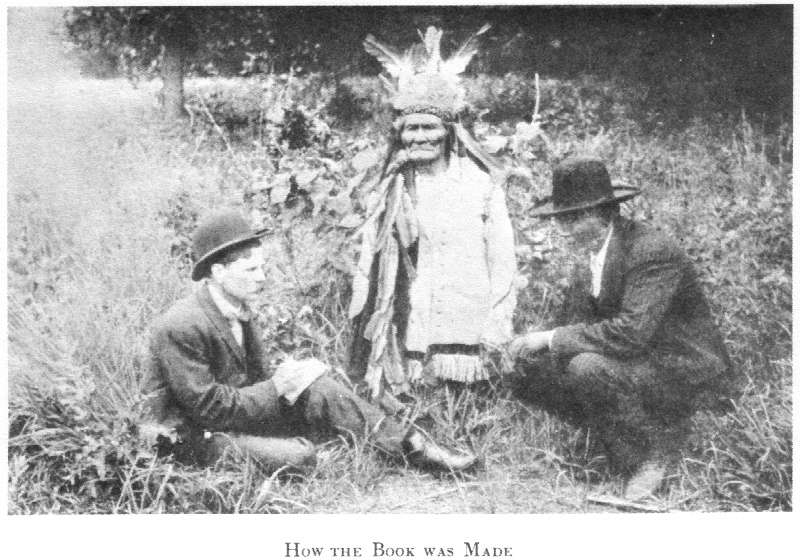
Geronimo - Chiricahua Apache - no date
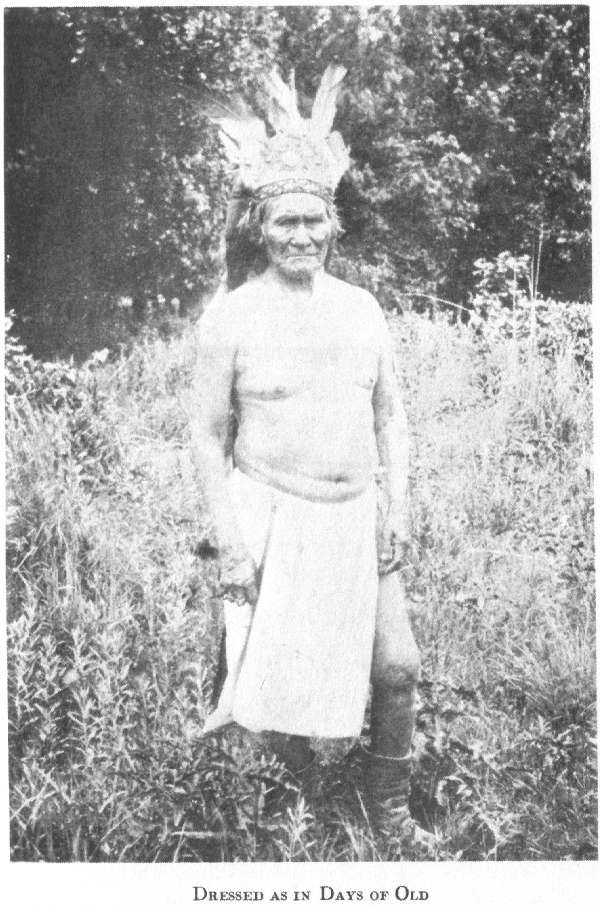
Geronimo - Chiricahua Apache - no date
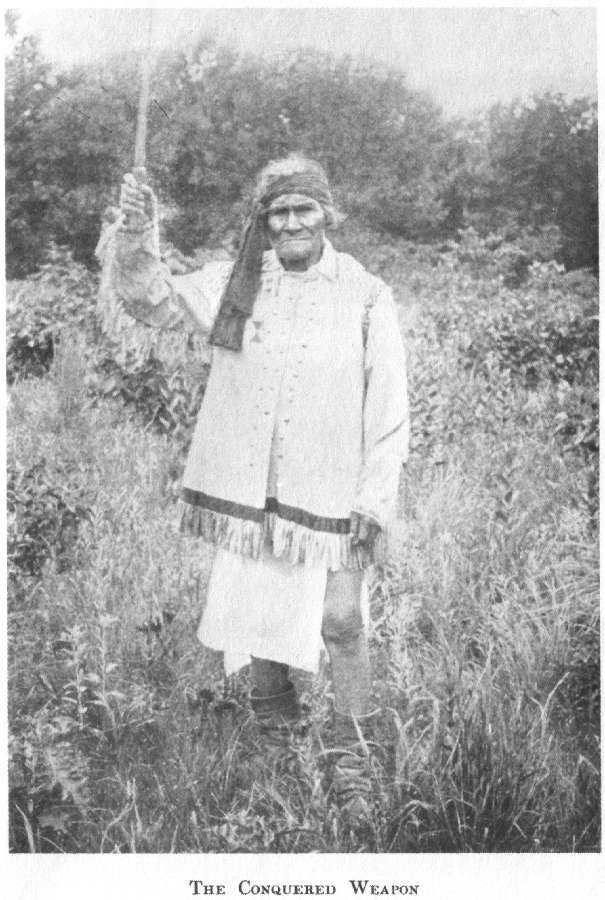
Geronimo (far left) - Chiricahua Apache - no date
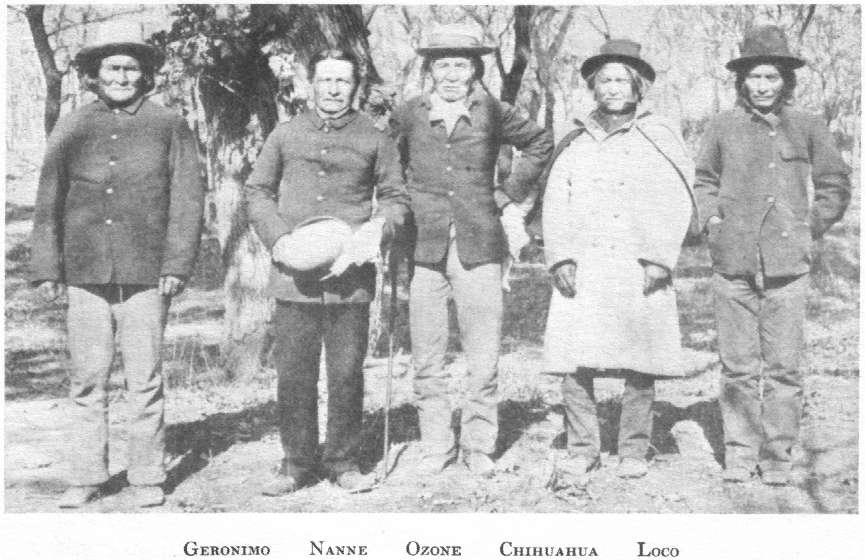
Geronimo (on left) - Chiricahua Apache - no date
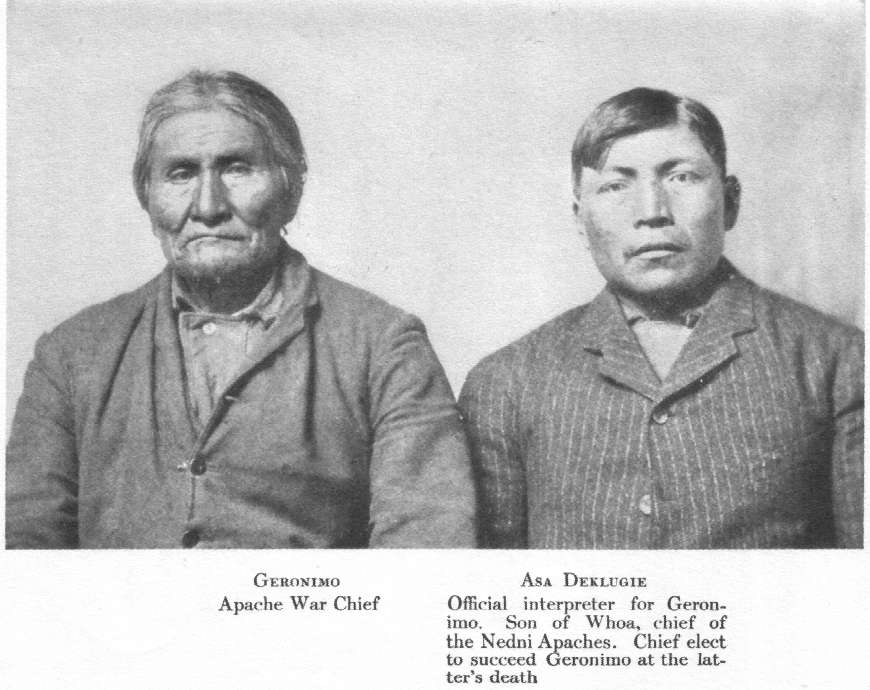
Geronimo (far right) - Chiricahua Apache - no date
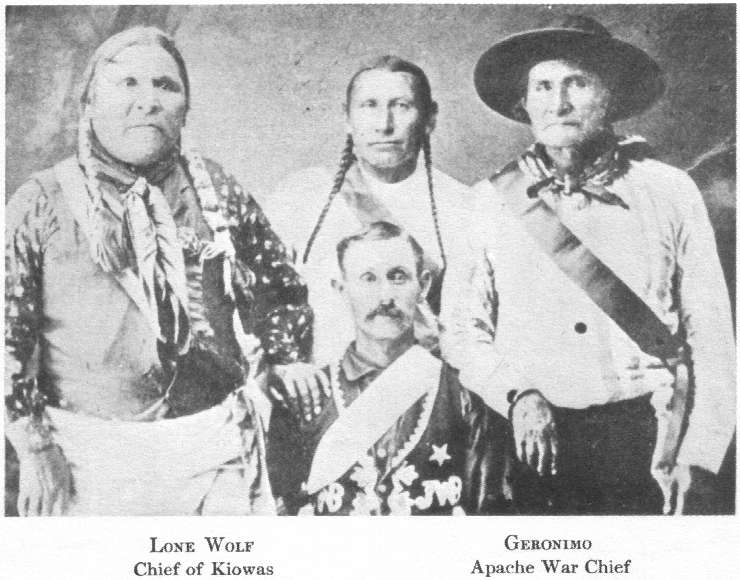
Geronimo - Chiricahua Apache - no date
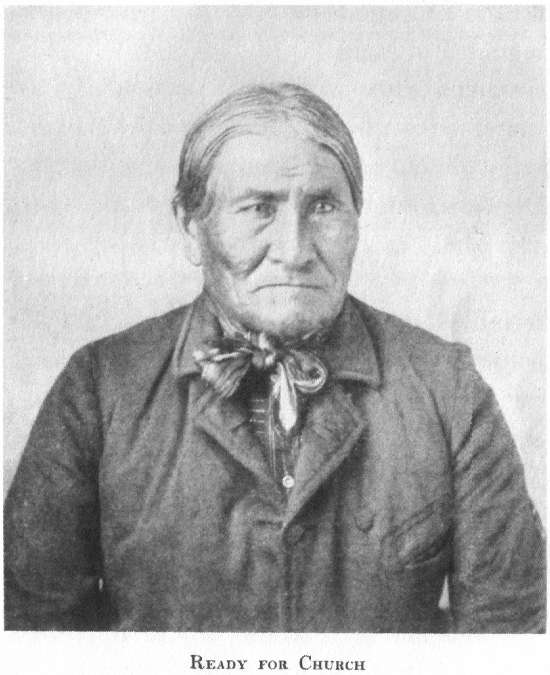
Geronimo and his two nieces - Chiricahua Apache - no date

Geronimo - Chiricahua Apache - no date

Geronimo - Chiricahua Apache - no date

by Barbara Ping
Geronimo was a Bedonkohe [Chiricahua] Apache who lived in the "Southern Four Corners" region (southeastern Arizona, southwestern New Mexico, northwestern Chihuahua, northeastern Sonora) during the late 1800's. Born in the 1820's, scholars disagree on whether his birthplace was actually in Arizona or New Mexico. His original name "Goyakla," or "one who yawns," was replaced with "Geronimo" by Mexican soldiers.
By the 1850's Geronimo was married with three children and also supporting his widowed mother. The entire Bedonkohe group went to Mexico in the summer of 1858 to trade with the Mexicans living in a town Apache's called Kas-ki-yeh (probably Janos). After their camp was established, the women and children remained behind while a group of men went into town to trade. On the third day, the men returned to the camp to discover that a band of Mexican soldiers from another town had come and massacred many people, mostly women and children. Among the dead were Geronimo's mother, wife, and children. From that day, he vowed vengeance upon the Mexican troopers. He became a War Chief, leading the Chiricahua Apache in raids on Mexican towns and villages as well as attacking people throughout southern Arizona and New Mexico.
Some people give Geronimo the distinction of being the last Indian to surrender to the United States but actually he surrendered several times. In 1884, Geronimo, the Bedonkohe tribe, and members of other Apache groups surrendered and were taken to the San Carlos Indian Reservation. In 1885, he and 144 others escaped from the reservation, but surrendered to U.S. authorities ten months later in Mexico. As they were brought back across the United States-Mexico border, however, Geronimo and a small band escaped fearing they would be murdered. This band remained at large for the next five months despite being hunted by 5,500 men in a sweeping search that ranged over 1645 miles.
The negotiations for Geronimo's final surrender took place in Skeleton Canyon, near present day Douglas, Arizona, in September, 1886. He and approximately 40 others, as well as Western Apache scouts who had faithfully served the U.S. military in tracking Geronimo's band, were taken into custody. General Nelson A. Miles promised that they would be able to return to Arizona after a short incarceration in Florida.
The group was sent by train to Florida where they were detained for a year at Fort Pickens and their families at Fort Marion. The warriors were reunited with their families the following year at Mount Vernon, Alabama. The entire group was moved to Fort Sill, Oklahoma in 1894, still classified as "prisoners of war". Geronimo lived at Fort Sill until his death, in 1909, at the age of 85. During his later life Geronimo was a celebrity. He made appearances at the 1898 Trans-Mississippi and International Exposition, the 1901 Pan American Exposition, and the 1904 Louisiana Purchase Exposition and was often presented as the "Apache terror." He was also given the honor of riding in Theodore Roosevelt's inaugural parade after which he was given a personal audience with the President. Although he pled "Let me die in my own country, an old man who has been punished enough and is free," he was never allowed to return to Arizona.
*******
"Geronimo - The Last Apache Holdout"
by Kathy Weiser
Geronimo was born of the Bedonkohe Apache tribe in No-doyohn Canon, Arizona, June, 1829, near present day Clifton, Arizona. The fourth in a family of four boys and four girls, he was called Goyathlay (One Who Yawns.) In 1846, when he was seventeen, he was admitted to the Council of the Warriors, which allowed him to marry. Soon, he received permission; married a woman named Alope, and the couple had three children.
In the mid 1850s, the tribe, who was at peace with the Mexican towns and neighboring Indian tribes, traveled into Old Mexico where they could trade. Camping outside a Mexican town they called Kas-ki-yeh, they stayed for several days. Leaving a few warriors to guard the camp, the rest of the men went into town to trade. When they were returning from town, they were met by several women and children who told them that Mexican troops had attacked their camp.
They returned to camp to find their guard warriors killed, and their horses, supplies and arms, gone. Even worse, many of the women and children had been killed as well. Of those that lay dead were Goyathlay’s wife, mother, and three children and as a result, he hated all Mexicans for the rest of his life.
It was the slaughter of his family that turned him from a peaceful Indian into a bold warrior. Soon, he joined a fierce band of Apaches known as Chiricahuas and with them, took part in numerous raids in northern Mexico and across the border into U.S. territory which are now known as the states of New Mexico and Arizona. It was those Mexican adversaries that gave him the nickname of "Geronimo", the Spanish version of the name "Jerome".
In ever increasing numbers, Geronimo fought against both Mexicans and white settlers as they began to colonize much of the Apache homelands. However, by the early 1870s, Lieutenant Colonel George F. Crook, commander of the Department of Arizona, had succeeded in establishing relative peace in the territory. The management of his successors, however, was disastrous.
In 1876 the U.S. government attempted to move the Chiricahua from their traditional home to the San Carlos Reservation, a barren wasteland in east-central Arizona, described as "Hell's Forty Acres." Deprived of traditional tribal rights, short on rations and homesick, they revolted.
Spurred by Geronimo, hundreds of Apaches left the reservation and fled to Mexico, soon resuming their war against the whites. Geronimo and his followers began ten years of intermittent raids against white settlements, alternating with periods of peaceful farming on the San Carlos reservation.
In 1882, General George Crook was recalled to Arizona to conduct a campaign against the Apaches. Geronimo surrendered in January 1884, but, spurred by rumors of impending trials and hangings, took flight from the San Carlos Reservation on May 17, 1885, accompanied by 35 warriors, and 109 other men, women and children.
During this final campaign, at least 5,000 white soldiers and 500 Indian auxiliaries were employed at various times in the capture of Geronimo's small band. Five months and 1,645 miles later, Geronimo was tracked to his camp in Mexico's Sonora Mountains.
Exhausted, and hopelessly out numbered, Geronimo surrendered on March 27, 1886 at Cañon de Los Embudos in Sonora, Mexico. His band consisted of a handful of warriors, women, and children. Also found was a young white boy named Jimmy "Santiago" McKinn, that the Indians had kidnapped some six months earlier in September. The "rescued" boy had become so assimilated to the Apache lifestyle, he cried when he was forced to return to his parents.
Also traveling with General Crook was the photographer, C.S. Fly of Tombstone fame. After the bands capture, he was able to take some of the most famous photographs in U.S. history.
The soldiers gathered the group and began the trek to Fort Bowie, Arizona. However, near the border, Geronimo, fearing that they would be murdered once they crossed into U.S. territory, bolted with Chief Naiche, 11 warriors, and a few women and boys, who were able to escape back into the Sierra Madra. As a result, Brigadier General Nelson A. Miles replaced Crook as commander on April 2, 1886.
At a conference on September 3, 1886, at Skeleton Canyon in Arizona, General Miles induced Geronimo to surrender once again, promising him that, after an indefinite exile in Florida, he and his followers would be permitted to return to Arizona.
The promise was never kept. Geronimo and his fellow prisoners were shipped by box-car to Florida for imprisonment and put to hard labor.
It was May 1887 before he saw his family. Several years later, in 1894, he was moved to Fort Sill in Oklahoma Territory where he attempted to “fit in.” He farmed and joined the Dutch Reformed Church, which expelled him because of his inability to resist gambling.
As years passed, stories of Geronimo's warrior ferocity made him into a legend that fascinated non-Indians and Indians alike. As a result, he appeared at numerous fairs, selling souvenirs and photographs of himself. In 1905 he was quite the sensation when he appeared in President Theodore Roosevelt's inaugural parade. Geronimo dictated his memoirs, published in 1906 as Geronimo's Story of His Life.
Never having seen his homeland of Arizona again, Geronimo died of pneumonia on February 17, 1909 and was buried in the Apache cemetery at Fort Sill, Oklahoma.
*******
Geronimo with General George Crook in council - 27 March 1886

Geronimo - Chiricahua Apache - 1886

Geronimo - Chiricahua Apache - 1886

Geronimo - Chiricahua Apache - 1886

{The photograph below, taken on 10 September 1886 shows Apache prisoners at rest stop near Nueces River, Texas along the route to Fort Sam Huston in San Antonio.}
Naiche (seated in front - third from left), Geronimo (seated in front - third from right) - Chiricahua Apache - 1886

Geronimo - Chiricahua Apache - 1886

Geronimo - Chiricahua Apache - 1886

Geronimo (far right) at Ft. Sam Huston, San Antonio, TX - Chiricahua Apache - 1886

Geronimo (standing in center) at Ft. Sam Huston, San Antonio, TX - Chiricahua Apache - 1886

Geronimo at Ft. Sam Huston, San Antonio, TX - Chiricahua Apache - 1886

Geronimo at Mt. Vernon Barracks, Alabama - Chiricahua Apache - 1887

Geronimo (far right) at Mt. Vernon Barracks, Alabama - Chiricahua Apache - 1887

Geronimo - Chiricahua Apache - 1897

Geronimo (center) - Chiricahua Apache - 1901

Geronimo - Chiricahua Apache - 1903

Geronimo - Chiricahua Apache - 1904

Geronimo - Chiricahua Apache - 1905

{The photo below shows Geronimo driving a car. It was taken on 11 June 1905, at the Miller brothers' 101 Ranch, located southwest of Ponca City, Oklahoma. The "photo op" was taken during a special 101 Ranch show for the press, and hundreds of newspaper editors and reporters flocked to it. At the time, Geronimo was still imprisoned at Fort Sill, Oklahoma, and guards accompanied him to the show. The man in a feathered headdress to Geronimo's left is Edward LeClair Sr. (Ponca). Geronimo so admired LeClair's beaded vest that he was presented to him later in the day. When Geronimo died in 1909, he was buried in the vest.}
Geronimo - Chiricahua Apache - 1905
Geronimo - Chiricahua Apache - 1907

Geronimo - Chiricahua Apache - no date

Geronimo - Chiricahua Apache - no date

Geronimo and family at Fort Sill, OK - Chiricahua Apache - no date

Geronimo - Chiricahua Apache - no date

Geronimo - Chiricahua Apache - no date

Geronimo (Chiricahua Apache), Christian Waiche - no date

Geronimo - Chiricahua Apache - no date

Geronimo - Chiricahua Apache - no date

Geronimo (center) - Chiricahua Apache - no date

Geronimo - Chiricahua Apache - no date

Geronimo - Chiricahua Apache - no date

Geronimo (far left) - Chiricahua Apache - no date

Geronimo (on left) - Chiricahua Apache - no date

Geronimo (far right) - Chiricahua Apache - no date

Geronimo - Chiricahua Apache - no date

Geronimo and his two nieces - Chiricahua Apache - no date

Geronimo - Chiricahua Apache - no date

Geronimo - Chiricahua Apache - no date







